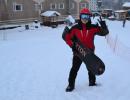Thoracic vertebrae and their features. How many thoracic vertebrae does a person have? Osteochondrosis of the thoracic vertebrae
Everyone knows that the main supporting axis of the human skeleton is its spine. That is why so much attention is paid to it - without the proper work of this body, a person loses the main part of his life.
Anatomy of the human spine
The anatomy of our body tells us that this important supporting element is not as simple as it seems at first glance - it is divided into 5 parts. The structure of the pillar includes: cervical, thoracic, lumbar, sacrum and coccyx. The total number of vertebrae in all departments: 7 cervical, 12 thoracic, 5 lumbar, 4-5 coccyx. In addition, several fused bones make up the sacrum.
Evolution has created the human body as it is today: moderately mobile and at the same time capable of unique actions (as the Guinness Book of Records will tell). A person owes most of his abilities to the spine, as well as to the organs surrounding it and supporting it: ligaments, muscles, intervertebral discs, and even the spinal cord located inside the column.
"Helpers" of the spinal column
Each vertebra, regardless of belonging to a particular department, has a more massive part located in front, which takes all the main load on itself. This is his body. An arc departs from it, forming a ring together with the body, the brain is located in it with the back. From here the vertebral processes come out. They perform a connecting function. All together, the cervical, thoracic, in one column are combined with the help of intervertebral discs. In addition, this design is supported by ligaments and muscles. The sizes of the intervertebral discs vary, in an adult they can reach 25% of the entire length of the spine. In addition, their sizes also differ by department: in the cervical and lumbar discs, they are larger, since there it is necessary to ensure the greatest mobility.
thoracic vertebra
The thoracic vertebrae take on a little more load than their "brothers", so you can notice slight differences in their structure. One of them is a more massive vertebral body. In addition, the neighbors of these elements are the ribs, hence the difference in anatomy.

The divisions of the thoracic vertebrae are as follows: superior and inferior vertebral notches, superior and inferior articular process, transverse process and its costal fossa, vertebral body, superior and inferior costal fossae, spinous process, vertebral arch, and vertebral foramen.
The purpose of the costal pits is to connect the vertebral body with the ribs. They are located next to the arc. The location of the ribs between the two "neighbors" determines the presence of an upper and lower fossa in the thoracic vertebra, however, they are incomplete (half). Nevertheless, there are exceptions here too - the 1st vertebra has only a complete and one lower half fossa for the corresponding 1st and 2nd ribs. Also, the 10th vertebra has one half fossa, intended for the corresponding rib, and the 11th and 12th "assistant" acquired only a full fossa for the corresponding "neighbors".

In the features of the thoracic vertebrae, you can also add a structure. They are longer and inclined downwards, where, when combined, they form something similar to a tile. This feature is easiest to see at the level of the 4th-10th vertebrae.
What is thoracic kyphosis?
The flexibility of the spine is one of his main abilities, it is acquired in the process of development. There are such concepts as lordosis and kyphosis. Lordosis is the ability of the cervical and lumbar to bend forward, and kyphosis is the ability of the thoracic and sacral to bend backward.
It often happens that under the influence of injuries or weakened muscles and ligaments, abnormal posture begins to develop. This in turn leads to a number of diseases.

The anatomical properties of the spine contribute to the fact that the thoracic vertebrae, forming a thoracic kyphosis, can take on a large load and absorb it. However, it must be remembered that the displacement of this load in one direction or another can lead to deformation of the shape of the vertebral body or have a destructive effect on the intervertebral region.
Osteochondrosis of the thoracic vertebrae
This disease is one of the most common in the thoracic region of the musculoskeletal system. By its nature, it is somewhat different from a similar disease in another department, because, as previously noted, the structure of the vertebrae is somewhat different.

It can be seen that the thoracic vertebrae are less mobile. But this department can be distinguished by rather painful sensations, since the spinal nerves from this zone innervate the entire shoulder girdle and upper limbs. And also the internal organs of the chest and abdominal region can take a blow on themselves. Here is also the narrowest spinal canal and the small size of the vertebrae themselves, and, therefore, the most favorable conditions for the development of disc herniation.
What are the causes of thoracic osteochondrosis?
In order to understand what is the cause of the disease, let's pay attention to who is most often exposed to it?
- People with impaired metabolism and overweight.
- Leading a sedentary lifestyle.
- Patients with hypertension, diabetes mellitus, with pathology of the thyroid gland.
- People who stay for a long time in an uncomfortable position.
- Patients with osteochondrosis of the cervical region.
- Patients with scoliosis or excessive kyphosis.
Signs of thoracic osteochondrosis
The disease is characterized by a wide variety of symptoms. Probably, how many thoracic vertebrae a person has, so many manifestations of osteochondrosis. This diversity is due to a large zone of innervation emanating from the thoracic spinal cord. Very often there is an infringement or inflammation of the radicular nerves. This process is accompanied by a pain syndrome of varying intensity and localization. However, it can even lead to violations of the functions of internal organs.
Symptoms that the thoracic vertebrae are affected by osteochondrosis are as follows:
- Backache.
- Girdle with greater intensity on inspiration.
- Numbness, "goosebumps" in the chest.
- Heartache.
- Abdominal pain.
- Pain and decreased muscle activity in the upper extremities.
- Disorder of the work of internal organs due to innervation.
Displacement of the thoracic vertebrae
Under the literary medical diagnosis "subluxation of the vertebrae", the well-known displacement of the thoracic vertebrae was hidden. Its symptoms are very similar to osteochondrosis. Such an outcome is preceded by a change in the location of the vertebra or damage to the fibrous ring of the intervertebral disc, which leads to narrowing of the entire canal, compression of nerve fibers and blood vessels and, as a result, pain and swelling.

The difference between a subluxation and a dislocation is that although the articular surfaces move, they continue to touch.
Since the thoracic vertebrae are less exposed to loads and less involved in motor activity than others, displacement in the thoracic region is a rare occurrence. Most often, this pathology occurs in the cervical region. However, if the displacement did occur, then complications are more dangerous here. This can lead to impaired blood supply or circulation of cerebrospinal fluid. Considering how many thoracic vertebrae, the consequences of subluxation can also include:
- Difficulty breathing or asthma (subluxation of the 1st thoracic vertebra).
- Violation of the heart (subluxation of the 2nd thoracic vertebra).
- Broncho-pulmonary malaise (subluxation of the 3rd thoracic vertebra).
- Pancreatitis and other diseases of the biliary tract (subluxation of the 4th vertebra).
- Arthritis (displacement of the 5th thoracic vertebra).
- Gastric ulcer, gastritis (6-7 vertebrae).
- Reduced immunity (8 vertebra).
- Kidney dysfunction (displacement of the 9th vertebra).
- Intestinal disorders, visual impairment, problems in the work of the heart (10th vertebra).
- Skin diseases (subluxation of the 11th vertebra).
- Rheumatism and even infertility as a result of displacement of the 12th vertebra.
Symptoms include the following manifestations:
- sharp then pulling, which becomes noticeably aggravated during the movement of the torso.
- Limited mobility of one or both hands.
- Weakness.
- Muscle tension.
Fractures of the thoracic spine
One of the most difficult diseases of the spine is a fracture. And the chest is no exception. According to localization among the fractures in this department, fractures of the 5th, 6th, 7th thoracic vertebrae, 9th-12th, transverse and spinous processes are distinguished.

Due to the occurrence, several types are distinguished. This is a post-traumatic fracture of the thoracic vertebrae (consequences of severe accidents or sports injuries), when a weight falls on the shoulders of the victim, when falling from a height; paratroopers and paratroopers as a result of labor activity. Fractures due to metastases to the spine or osteoporosis are less common, but they also occur.
By the nature of the damage, it is noted that more often fractures of the thoracic vertebrae are not accompanied by displacement and very rarely are accompanied by damage to the spinal cord.
Our spine is our support in the literal and figurative sense, a person's life changes dramatically if there comes a moment when we lose it. That is why it is so important to know more about this organ and take better care of its health.






